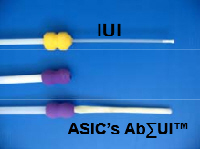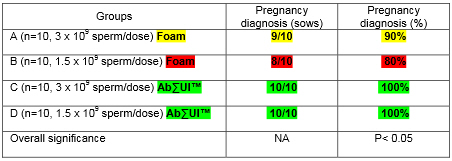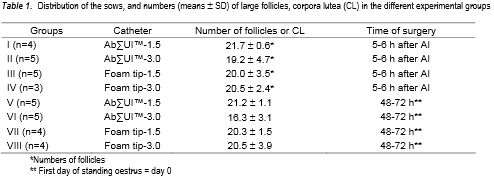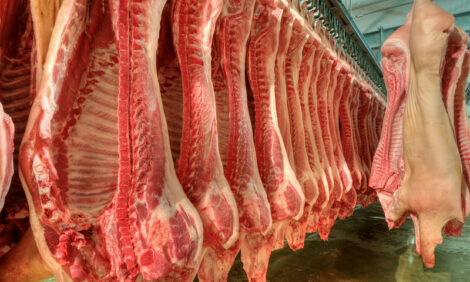



Sow Pregnancy Rates Compared: ASIC versus Foam Catheters
THAILAND - Sow pregnancy rates were higher using a catheter from Absolute Swine Insemination Company (ASIC) than a conventional foam-tip catheter, according to K. Kaeoket, D. Laohasinnarong and P Chanapiwat of Mahidol University.During the last decade, Intra-Uterine Insemination (IUI) has been developed and used both for research and practice on farm. The benefits of using IUI technique are not only to reduce the number of spermatozoa (1-2 × 109 per dose) used at insemination (getting more sows to be inseminated) but also to diminish semen back flow and sperm losses after insemination.
In pigs, it has been shown that the optimal insemination time in order to achieve a good fertilisation rate is within 24 hours before ovulation. The ability of a pig oocyte to be fertilised has been considered to be as short as eight to 12 hours after ovulation. Subsequently, insemination after ovulation results in impaired farrowing rate and litter size.
In addition, it is well documented that the sows with a longer weaning-to-oestrus interval (WOI) had a shorter duration of oestrus, consequently had a shorter ovulation time, i.e. a shorter time from standing oestrus to ovulation. In other words, sows with a shorter weaning-to-oestrus had a longer duration of oestrus, and consequently had a longer ovulation time.
For that reason, the timing of AI should be adjusted by using the WOI. Nonetheless, this is the first study to be published on the relationship of WOI and timing of AI by using ASIC’s Ab∑UI™ Hydraulic Injection Insemination System.

ASIC catheters contain a membrane (see picture) inside a foam tip which enables their catheter to easily go through the cervix by pressurising a container of semen; without damaging the cervix.
Therefore, the aim of the present study was to investigate the efficacy of using ASIC’s Ab∑UI™ Hydraulic Injection Insemination System on the pregnancy rate after adjusted timing of AI with WOI.
Materials and Methods
Forty crossbred (Landrace × Yorkshire) multiparous sows from a commercial herd with an average parity number of 3.6±1.2 (mean ± S.D.) were used in this study. Prior to this study, the sows had shown a normal reproductive performance. The sows were kept in individual crates and boars were housed in the same stable throughout the experimental period. The sows were fed twice a day. Water was available ad libitum.
Oestrous detection was performed by inspection of the vulva for reddening and swelling (pro-oestrus) as well as by control of the standing reflex (oestrus) in the presence of a boar. The oestrous detection was carried out twice daily.
Sows were inseminated according to their WOI: three to four days, inseminated at 24 hours and 36 hours after standing oestrus; 5-6 days, inseminated at 12 and 24 hours after standing oestrus; ≥7 days, inseminated at 0 and 12 hours after standing oestrus.
Semen from boars of proven fertility were used during the experimental period. BTS extender was used for semen processing.
Forty sows were divided into four groups:
- Group A (10 sows): inseminated by using a foam tip (3×109 spermatozoa/80ml)
- Group B (10 sows): inseminated by using a foam tip (1.5×109 spermatozoa/80ml)
- Group C (10 sows): inseminated by using Ab∑UI catheter (3×109 spermatozoa/80ml)
- Group D (10 sows): inseminated by using Ab∑UI catheter (1.5×109 spermatozoa/80ml).
The insemination for a foam tip was carried out in the presence of a boar. However, when using Ab∑UI catheter, insemination was performed by absent of a boar. All sows were subjected to pregnancy diagnosis on days 20-22 after insemination by using real time ultrasound (50STringa, sector probe with 5MHz, ESAOTE Pie Medical, The Netherlands).
Results
The average weaning to oestrus interval was 4.3 ± 0.9 (mean ± S.D.) days, with a range of three to nine days. The pregnancy rates are presented in Table 1.

Discussion and Conclusion
The present results confirm the previous studies in that a lower dose insemination (1.5 x 109 sperm) with Ab∑UI catheter does not negatively affect pregnancy rates.
Comparing ASIC’s Ab∑UI™ catheters to foam-tip catheters, a higher pregnancy rate was found with Ab∑UI catheters.
This might be due to semen backflow being diminished when using Ab∑UI catheters. However, further investigation is needed, in order to compare the farrowing rate and litter size.
In conclusion, based on this result, the ASIC’s Ab∑UI catheter can be an alternative IUI catheter for swine industry and also fixed-time insemination using WOI as a tool resulted in a satisfy pregnancy rate.
Acknowledgement: Absolute Swine Insemination Co., LLL (ASIC) USA, is thanked for providing ASIC Ab∑UI catheters for the experiment.
Experiment I: sperm distribution and fertilisation rate



Experiment II (%PR, %FR, NTB and NBA)

For all the parameters, no extreme significance was found; however, a tendency to improve pregnancy rate and farrowing rate was found and this is a good thing.
Profits and overall farm efficiencies resulting from increased conception and farrowing rates can be very significant.
Non-parametic test, Cochran test, and SPSS programme was used to compare pregnancy rate and farrowing rate. GLM, Univariate analysis of variance, Duncan’s test, and SPSS programme was used to compare NTB and NBA.







